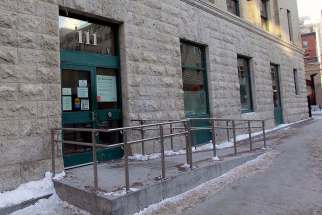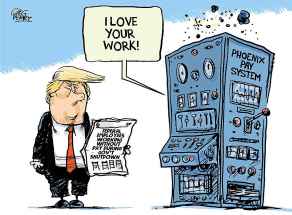Shields alone are not enough Barriers just one part of urgently needed security upgrade on city buses
Read this article for free:
or
Already have an account? Log in here »
To continue reading, please subscribe:
Monthly Digital Subscription
$19 $0 for the first 4 weeks*
- Enjoy unlimited reading on winnipegfreepress.com
- Read the E-Edition, our digital replica newspaper
- Access News Break, our award-winning app
- Play interactive puzzles
*No charge for four weeks then billed as $19 plus GST every four weeks. Offer only available to new and qualified returning subscribers. Cancel any time.
Read unlimited articles for free today:
or
Already have an account? Log in here »
Hey there, time traveller!
This article was published 23/01/2019 (2166 days ago), so information in it may no longer be current.
Winnipeg Transit drivers wanted increased security and Winnipeg city council had the money to give it to them. No matter how you look at council’s decision this week to expedite the purchase and installation of safety shields in buses, it seems like the perfect marriage of motive and opportunity.
The timing of the decision, as well, could not have been more poignant.

While Mayor Brian Bowman and the councillors on his executive policy committee were examining a motion to spend $3.1 million to install shields on buses, the city was reeling from the release of an alarming security video from February 2017 showing the onboard confrontation between a passenger and Winnipeg Transit driver Irvine Jubal Fraser that ended moments later when Fraser was stabbed to death outside, out of the camera’s view.
The video shows Fraser telling the lone passenger to leave the bus after arriving at the route’s final stop on the University of Manitoba’s Fort Garry campus at about 2 a.m.
Fraser repeatedly tells the passenger to leave the bus, but he refuses, apparently concerned about being left at the stop, some distance from a major route in the cold. Fraser is seen physically forcing the man off the bus and it appears he’s then spat upon and follows the man outside.
(Warning: Video includes strong language)
Almost immediately, the Amalgamated Transit Union local that represents most Winnipeg Transit workers demanded improved safety measures, including the purchase and installation of shields on the city’s bus fleet to protect drivers.
That was nearly two years ago and — fuelled by what it says is a constant threat to the safety of both drivers and passengers — combined with the unexpected arrival of a $12.8-million Transit operating surplus, the union asked for the shields to be in place within 18 months and the councillors on the city’s public works committee agreed.
Then on Tuesday, Bowman and EPC did the proposal one better, deciding to fold the cost of buying and installing the shields into the city’s 2019 capital budget — leaving the surplus to be spent on other Transit priorities — and get it done in a year.
Council as a whole is virtually certain to approve the shields. And in embracing the idea, Winnipeg is really only following a path taken by other major cities in Canada and the United States.

Edmonton city council last fall approved $20 million in additional security measures for its buses and trains, including $11 million for safety shields. Brampton joined the parade in June 2018, when it decided to outfit its entire existing fleet with shields, while ensuring all new bus purchases come pre-loaded with shields. Minneapolis, as well, is in the midst of a multi-year program to outfit all of its buses and trains with shields.
However, notwithstanding the consensus and the prudent use of taxpayer money, there are many reasons to view this proposal with caution. In short, shields are only a small part of the solution we need for the much larger security problem afflicting certain Winnipeg Transit routes.
The ATU points out that the gross majority of incidents involving drivers and violent or disruptive passengers would be eliminated with shields. A recent review by the union of 57 driver assaults concluded that 42 could have been prevented if shields had been in place.
Those findings confirm that, in most instances, drivers are at greatest risk when they are in their seats with their hands on the steering wheel and their attention focused on the road.
However, although it may seem like an obvious observation, a shield would not have solved the problem that Fraser faced, or saved his life. Fraser got into a physical confrontation with a passenger at the entrance of the bus, and then was drawn outside onto the street. A shield could only have protected him if he had used it to keep a safe distance between himself and the passenger.
Once you accept that reality, you quickly realize that shields do nothing to help drivers remove an intoxicated or otherwise disoriented passenger from the bus. Furthermore, the shield provides no security for anyone else on the bus who does not have the option of retreating behind a physical barrier.
Shields do nothing to help drivers remove an intoxicated or otherwise disoriented passenger from the bus. Furthermore, the shield provides no security for anyone else on the bus who does not have the option of retreating behind a physical barrier.
The shields are a good expenditure if they are part of a wider implementation of security measures. The city has more than 50 transit inspectors who are trained to de-escalate some situations. A study is underway about whether they could be given the power and training to detain unruly passengers.
As well, Winnipeg police officers on foot-patrol duty are spending an increasing amount of time each month using buses to travel between calls and to provide additional security.
However, so much more needs to be done.
There aren’t enough transit inspectors to address the size of the problem, and they aren’t trained or empowered to deal with the spectrum of incidents that erupt on some routes.
The ATU has asked for a dedicated transit police unit, but the Winnipeg Police Association staunchly opposes using cadets or other security personnel to deal with potentially violent situations.
The fact is, without a concerted effort to establish a more regular security presence on buses, the threat of violence remains. Unless city council comes up with a more comprehensive plan, the investment in shields is more of a stop-gap than a solution.
dan.lett@freepress.mb.ca

Dan Lett
Columnist
Born and raised in and around Toronto, Dan Lett came to Winnipeg in 1986, less than a year out of journalism school with a lifelong dream to be a newspaper reporter.
Our newsroom depends on a growing audience of readers to power our journalism. If you are not a paid reader, please consider becoming a subscriber.
Our newsroom depends on its audience of readers to power our journalism. Thank you for your support.













